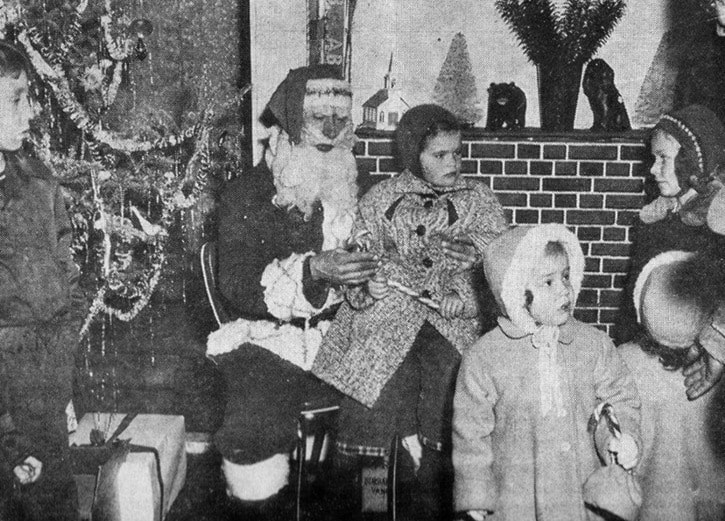The glorious joy of Christmas…..the birth of the Christ child has been celebrated by millions of families of all walks of life around the world for countless centuries. Along the way, countless very meaningful traditions and customs have been developed and proudly presented in so many unique and colorful settings, and have been carried on through generations of families and friends in a theme of good fellowship and fun. These grand celebrations are featured throughout the month of December and into the new year, and are magically performed and practised by young and old in the form of music and song, dance, costumes, pageants, and culinary sensations from moms and great-grandmas.
Christmas around the world
*In Canada and the United States, the most popular giver of gifts at Christmastide (at least for the little children and those who remain young at heart)) is a jolly old gentleman known as Santa Claus. He is also called St. Nicholas in many other parts of the world, where he and his amazing reindeer stop at every home on Christmas Eve… visit that is as long as we have been good.
*Other delightful Canadian festive traditions include sleigh rides with bells a jingling and hopes for lots of snow, the sending of Christmas cards (which have now been slightly adjusted into flashy electronic greetings across the airwaves, lots of gala and glitzy Santa Claus parades, Christmas light-up events and contests, the age-old ‘taffy pull’ in northern Canada, as well as cookie baking parties, carolling, singing and dancing around the community in the spirit of the occasion.
*Shortbread, like tweeds and whiskey, is claimed to have originated in Scotland hundreds of years ago, and is passionately celebrated at Christmas, and long into the New Year. In Spain, Mexico, Peru, and Costa Rico, the magnificent Nativity scene is always the centre of Christmas celebrations in every home, and following Midnight Mass, great celebrations and dances are hosted featuring bands, choirs, guitars and costumes, followed by the chosen feast of each nation, with everyone having a merry old time, some all the way to New Years Eve.. In hot countries such as Australia the Christmas meal is usually a few cool beers and a barbecue of ham, steak, or sausages in the back yard, and then it is off to the beach in the afternoon, followed by a relaxing day of watching cricket on Boxing Day. The Chinese call it the Holy birth festival, while the Swedes believed that the animals would talk at the stroke of midnight on Christmas Eve.
*The English refer to their giver of gifts as Father Christmas and for years had the custom of burning large blazing Yule logs in their fire-places, then over in Wales the carollers make their musical rounds early on Christmas morning and hope to be asked into the warm homes and fed breakfast, the Fins covered the floors of their homes with straw, and the Danes prefer goose instead of turkey, then sit around and wait for the Yule Man to bring gifts and hope that the Little Gremlins don’t play to many pranks. Another long-standing tradition is the celebration of Boxing Day, which was originated in England when the postman, the milkman and all the servants received a gaily wrapped gift in a box, but now it has become just an extra day of wild shopping. The Pennsylvania Dutch had a fine custom of making up their own Nativity scenes during the festive holidays, and then went around from house to visit and see which scene was the best. The little children of France used to put out their shoes on Christmas Eve with hopes that Pere Noel would come along and fill them with gifts, but now those big red socks seem to work better. In the early days in Holland St. Nicholas brought the children their gifts on December 5th, because that was his anniversary, where he would make his annual appearance riding a white horse, dressed in a long red robe, and accompanied by his servant Black Peter.
*History claims that Martin Luther created the first lighted Christmas tree after looking out of the window of a castle he was a guest at on Christmas Eve. He saw stars shining through the boughs of a giant fir tree and one very bright star stood in the firmament on the top of the tree. Luther later chopped down a small fir tree in the nearby forest, bought it inside the castle, and then decorated it with candles, with the largest on the top representing the Star of Bethlehem. Two of the largest surviving Christmas trees in the world are a 3500 year old giant sequoia in California and a Spanish moss in a North Carolina park that weights 6 tons. Canada has always been one of the largest suppliers of natural Christmas trees in the world, but that changed drastically when those artificial models came along.
Of course there have been many more wonderful and magic Christmas customs and traditions throughout the world, many of which are still carried on to this day, with a modern touch likely added here and there. Whatever the case it is our choice to celebrate this festive holiday season as we wish, but the most rewarding and heartfelt experience is to be able to share it in the company of family, friends, neighbours, and community.
